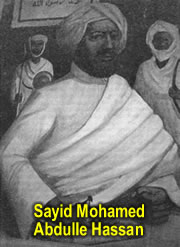By Markus V. Hoehne
The Somali Dervish ‘state’ was related to the Dervish uprising, that shook the British Protectorate and other parts of northern and also partly southern Somalia between 1899 and 1920. A ‘state’ implies a minimum of centralised and institutionalised power (i.e., a government), a territory and a population. The Somali Dervish state indeed featured a clear centralised governance structure, with Sayid Mohamed Abdille Hassan on top. The Sayid (which is an honorary title; the British called him ‘Mad Mullah’) was surrounded by a group of trusted commanders and advisors who were members of the Dervish council (in Somali called khusuusi). Together, the Sayid and the council controlled the military units. Islamic judges had the task of upholding law and order among the Dervishes and their kin. But clearly, Mohamed Abdille Hassan had the power to take the final decision in all matters he deemed important. The Somali Dervish state never had a clearly demarcated territory.
 The Dervishes operated between different temporary local centres (e.g., Aynabo, Buuhoodle, Eyl, Taleeh) in northern Somalia and, for a shorter period, had also stations in central Somalia such as Beledweyn. When confronted with superior colonial forces, their usual strategy was to retreat to the sparsely inhabited and arid hinterland. Also the population of the Somali Dervish state fluctuated. It consisted largely of the close patrilineal relatives and wives of the followers of Sayid Mohamed Abdille Hassan. Only temporarily did the Dervishes establish more permanent centres of power and ruled over larger areas. Therefore, it is appropriate to speak of the Somali Dervish movement/state.
The Dervishes operated between different temporary local centres (e.g., Aynabo, Buuhoodle, Eyl, Taleeh) in northern Somalia and, for a shorter period, had also stations in central Somalia such as Beledweyn. When confronted with superior colonial forces, their usual strategy was to retreat to the sparsely inhabited and arid hinterland. Also the population of the Somali Dervish state fluctuated. It consisted largely of the close patrilineal relatives and wives of the followers of Sayid Mohamed Abdille Hassan. Only temporarily did the Dervishes establish more permanent centres of power and ruled over larger areas. Therefore, it is appropriate to speak of the Somali Dervish movement/state.
Mohamed Abdille Hassan was the charismatic leader of the Dervish movement/state. He was a gifted poet, and Islamic scholar and a warrior. Born of an Ogadeen/Bah Geri father and a Dhulbahante/Ali Geri mother in the countryside near the village of Buuhoodle, in 1856 or in 1864 (Aw Jaamac 1976; Martin 2003 [1976]: 180), Mohamed grew up in a pastoral-nomadic environment (Aw Jaamac 1976: 3-5; Samatar 1982: 100). He then learned the Koran and became an itinerant sheikh (Somali: wadaad). In the 1890s Mohamed visited Mecca and Medina several times. He came into contact with Sheikh Mohamed ibn Salih in Mecca and joined his order, the Salihiya. Mohamed became a khalifa (initiator recruiting followers) for the order (Arabic: tariqa) in Somalia (Martin 2003 [1976]: 180; Aw Jaamac 1976: 6-7). The Salihiya belonged to the Islamic reform movements in the nineteenth century. Its teachings were inspired by the earlier ideas of ibn Taymiya (1262-1328) and Mohamed ibn Abdul-Wahab (1703-1792).
Read more: An appraisal of the ‘Dervish state
Markus V. Hoehne
Email:[email protected]
University of Leipzig
Germany
We welcome the submission of all articles for possible publication on WardheerNews.com. WardheerNews will only consider articles sent exclusively. Please email your article today . Opinions expressed in this article are those of the author and do not necessarily reflect the views of WardheerNews.
WardheerNew’s tolerance platform is engaging with diversity of opinion, political ideology and self-expression. Tolerance is a necessary ingredient for creativity and civility.Tolerance fuels tenacity and audacity.
WardheerNews waxay tixgelin gaara siinaysaa maqaaladaha sida gaarka ah loogu soo diro ee aan lagu daabicin goobo kale. Maqaalkani wuxuu ka turjumayaa aragtida Qoraaga loomana fasiran karo tan WardheerNews.
Copyright © 2024 WardheerNews, All rights reserved


